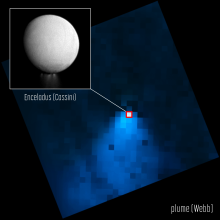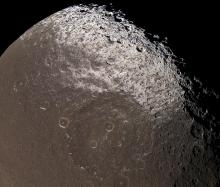Listen to today's episode of StarDate on the web the same day it airs in high-quality streaming audio without any extra ads or announcements. Choose a $8 one-month pass, or listen every day for a year for just $30.
You are here
Moon and Saturn
The planet Saturn stands close to the upper right of the Moon at first light tomorrow. It looks like a bright golden star.
Saturn has dozens of moons of its own. Titan, the biggest, has a thick atmosphere and lakes of liquid methane. And geysers of water and ice shoot into space from a distant moon, Enceladus.
Another moon is a lot less active, but it has some interesting features nonetheless: Straight lines up to hundreds of miles long that lie parallel to its equator.
Dione is Saturn’s fourth-largest moon. It’s about 700 miles in diameter, and orbits about 200,000 miles above Saturn\'s cloudtops. Its surface is made of ice. It’s scarred by impact craters and jagged cracks.
The stripes were revealed by photos from the Cassini spacecraft, which orbited Saturn for a decade. The stripes were studied by researchers from the Planetary Science Institute and the National Air and Space Museum.
The scientists found that the stripes are no more than three miles wide, but up to hundreds of miles long. They’re brighter than the surrounding landscape, and they’re completely straight — like stripes painted down a highway.
The researchers say the stripes probably were created by something other than Dione itself. They could have been deposited by a “rain” of ice from Saturn’s rings, or by passing comets. Or they could consist of material blasted off nearby moons by small space rocks — sprays of ice forming sporty stripes on Dione.
Script by Damond Benningfield






